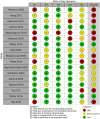The effectiveness of video animations as information tools for patients and the general public: A systematic review
- PMID: 36777110
- PMCID: PMC9910310
- DOI: 10.3389/fdgth.2022.1010779
The effectiveness of video animations as information tools for patients and the general public: A systematic review
Abstract
Background and objectives: Video animations are used increasingly as patient information tools; however, we do not know their value compared to other formats of delivery, such as printed materials, verbal consultations or static images.
Methods: This review compares the effectiveness of video animations as information tools vs. other formats of delivery on patient knowledge, attitudes and cognitions, and behaviours. Included studies had the following features: controlled design with random or quasi-random allocation; patients being informed about any health condition or members of the public being informed about a public health topic; comparing video animation with another delivery format. Multiple digital databases were searched from 1996-June 2021. We also undertook citation searching. We used dual, independent decision-making for inclusion assessment, data extraction and quality appraisal. Included studies were appraised using the Cochrane ROB2 tool. Findings were reported using narrative synthesis.
Results: We included 38 trials, focussed on: explaining medical or surgical procedures (n = 17); management of long-term conditions (n = 11); public health, health-promotion or illness-prevention (n = 10). Studies evaluated cartoon animations (n = 29), 3D animations (n = 6), or 2D animations, "white-board" animations or avatars (n = 1 each). Knowledge was assessed in 30 studies, showing greater knowledge from animations in 19 studies, compared to a range of comparators. Attitudes and cognitions were assessed in 21 studies, and animations resulted in positive outcomes in six studies, null effects in 14 studies, and less positive outcomes than standard care in one study. Patient behaviours were assessed in nine studies, with animations resulting in positive outcomes in four and null effects in the remainder. Overall risk of bias was "high" (n = 18), "some concerns" (n = 16) or "low" (n = 4). Common reasons for increased risk of bias were randomisation processes, small sample size or lack of sample size calculation, missing outcome data, and lack of protocol publication.
Discussion: The overall evidence base is highly variable, with mostly small trials. Video animations show promise as patient information tools, particularly for effects on knowledge, but further evaluation is needed in higher quality studies.
Systematic review registration: https://www.crd.york.ac.uk/prospero/display_record.php?, identifier: CRD42021236296.
Keywords: attitudes and cognition; behaviors; information tools; knowledge; patients; video animations.
© 2022 Moe-Byrne, Evans, Benhebil and Knapp.
Conflict of interest statement
The authors declare that the research was conducted in the absence of any commercial or financial relationships that could be construed as a potential conflict of interest.
Figures
Similar articles
-
Promoting and supporting self-management for adults living in the community with physical chronic illness: A systematic review of the effectiveness and meaningfulness of the patient-practitioner encounter.JBI Libr Syst Rev. 2009;7(13):492-582. doi: 10.11124/01938924-200907130-00001. JBI Libr Syst Rev. 2009. PMID: 27819974
-
The effectiveness of health literacy interventions on the informed consent process of health care users: a systematic review protocol.JBI Database System Rev Implement Rep. 2015 Oct;13(10):82-94. doi: 10.11124/jbisrir-2015-2304. JBI Database System Rev Implement Rep. 2015. PMID: 26571285
-
The Effectiveness of Integrated Care Pathways for Adults and Children in Health Care Settings: A Systematic Review.JBI Libr Syst Rev. 2009;7(3):80-129. doi: 10.11124/01938924-200907030-00001. JBI Libr Syst Rev. 2009. PMID: 27820426
-
Interventions to reduce ambient particulate matter air pollution and their effect on health.Cochrane Database Syst Rev. 2019 May 20;5(5):CD010919. doi: 10.1002/14651858.CD010919.pub2. Cochrane Database Syst Rev. 2019. PMID: 31106396 Free PMC article.
-
Telephone interventions for symptom management in adults with cancer.Cochrane Database Syst Rev. 2020 Jun 2;6(6):CD007568. doi: 10.1002/14651858.CD007568.pub2. Cochrane Database Syst Rev. 2020. PMID: 32483832 Free PMC article.
Cited by
-
The Effectiveness of Video Animations as a Tool to Improve Health Information Recall for Patients: Systematic Review.J Med Internet Res. 2024 Dec 30;26:e58306. doi: 10.2196/58306. J Med Internet Res. 2024. PMID: 39753224 Free PMC article.
-
What are the views of those participating in a trial investigating acute post-traumatic benign paroxysmal positional vertigo? A qualitative study.Brain Inj. 2025 Mar;39(5):400-409. doi: 10.1080/02699052.2024.2435952. Epub 2024 Dec 3. Brain Inj. 2025. PMID: 39627936 Free PMC article. Clinical Trial.
-
Postoperative rehabilitation management self-efficacy and its relationship with symptoms in the patients with lung cancer: A latent profile analysis.Asia Pac J Oncol Nurs. 2024 Jul 6;11(9):100554. doi: 10.1016/j.apjon.2024.100554. eCollection 2024 Sep. Asia Pac J Oncol Nurs. 2024. PMID: 39308940 Free PMC article.
-
Informational needs related to menstrual literacy among Dutch women: a focus group study.BMC Womens Health. 2025 Apr 4;25(1):158. doi: 10.1186/s12905-025-03694-3. BMC Womens Health. 2025. PMID: 40186197 Free PMC article.
-
Effect of AI-based pre-hospital health education via QR code on APAIS scores in patients with breast nodules: A retrospective study.Breast. 2025 Aug;82:104481. doi: 10.1016/j.breast.2025.104481. Epub 2025 Apr 24. Breast. 2025. PMID: 40367845 Free PMC article.
References
Publication types
LinkOut - more resources
Full Text Sources





